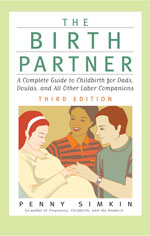Pain Management

What You Need To Know About Pain Medications
[Adapted from The Birth Partner, by Penny Simkin. Copyright © 2008, used by permission of The Harvard Common Press.]
To make an informed decision about pain medications during labor, you need some information:
- What is the drug? How does it work? How effective is it in relieving pain?
- What other effects does it have - on you, on the progress of labor, on the fetus, and on the newborn?
- What precautions or added interventions are needed to ensure safety?
Do not wait until you are in labor to get this information. When you are in pain and asking for medication, it is too late to try to learn all about the drugs.
Remember that, although various drugs are available, effective, and widely used in labor, they involve tradeoffs: You get pain relief, but you or the fetus may experience unwanted side effects-directly, from the drug itself, or indirectly, through potential problems such as restriction of your activity or the need for other interventions. Long-term detrimental effects on the baby of drugs used judiciously in labor have not been established. There may be no harm, or, in some cases, there may be subtle long-term effects. This is a subject of great debate in the medical literature, and it is unlikely to be settled in the near future.
For these reasons you may opt to use nondrug methods of pain relief at least for part of labor and to seek a birth place that has the amenities (bathtub, shower, squatting bar, birthing bed, places to walk, rocking chair) that enhance your comfort during labor. You may bring your own music, hot or cold packs, and birth ball if the hospital or birth center doesn't have them. If you're planning a home birth, you probably have furniture to lean on and hold on to for squatting and pillows to support you in various positions in bed.
By using nondrug pain-relief methods for at least part of your labor, you can comfortably postpone use of pain medications. In this way, you will reduce the total amount of medications you receive and lessen the likelihood of undesirable effects and the need for additional interventions.

Many women find these nondrug methods sufficient to keep their pain at a level at which they can cope throughout the labor. Afterward, the absence of drug side effects and the ability to get up and move freely immediately after the birth contribute to a feeling that the rewards are worth the pain.
Preparing to deal with labor pain using nondrug methods is time-consuming, however, and going through labor without drugs can be a challenge. And if labor is exhausting or complicated, the benefits of pain medications will outweigh the potential risks. Many women do not have the time or inclination to master the nondrug approaches, and so plan to rely on an epidural to take away most pain in labor, or wait to see whether they need it. About 70 percent of laboring American women use an epidural today.
As you learn more about pain medication, you will be able to make informed choices. Here are several definitions.
- Analgesia. Reduction of pain. Analgesics are drugs that relieve pain.
- Anesthesia. Loss of sensation, including pain sensation. Anesthetics are drugs that take away feeling.
- Systemic. Taken up by the bloodstream, affecting the entire body, and reaching the baby in concentrations similar to those reaching the mother.
- Neuraxial. Affecting areas of the body that are supplied by specific nerves coming from the spinal cord (the neuraxis is the brain and spinal cord.)
- Neuraxial analgesic. A pain medication injected near nerve roots in the spine to block or decrease awareness of pain in the area supplied by those spinal nerves.
- Block. Medication that interrupts the transmission of pain impulses, creating numbness.
- Local. Affecting specific tissues - in childbirth, the cervix, vagina, and perineum. A local anesthetic blocks the feeling provided by nerve endings in these tissues.
- General anesthesia. Complete loss of consciousness caused by a systemic medication, a general anesthetic.
When pain medications are used, several factors influence the area where pain is relieved and the severity of side effects:
- The choice of medication - a narcotic or narcotic-like drug, a sedative, a tranquilizer, an anesthetic gas, an injected anesthetic, or an amnestic.
- The total dose - the concentration of the drug, the volume of each dose, and the number of doses.
- The route of administration - injection into a muscle, a vein, the cervix, or the vaginal wall; inhalation into the lungs; injection into the epidural or spinal (intrathecal) space; or swallowing.
- Individual characteristics of the mother - her weight, her sensitivity to medications, her blood-clotting ability, her anatomic variations, her physical condition, the duration of her pregnancy, and her overall health.
 PREGNANCY
PREGNANCY  GIVING BIRTH
GIVING BIRTH  BABY CARE
BABY CARE  HEALTH & SAFETY
HEALTH & SAFETY  FUN STUFF
FUN STUFF  FAMILY
FAMILY 